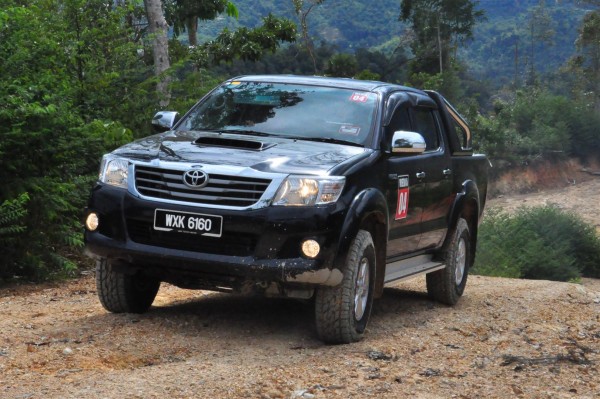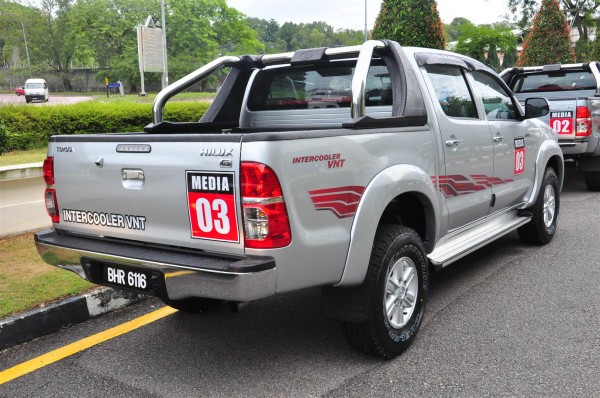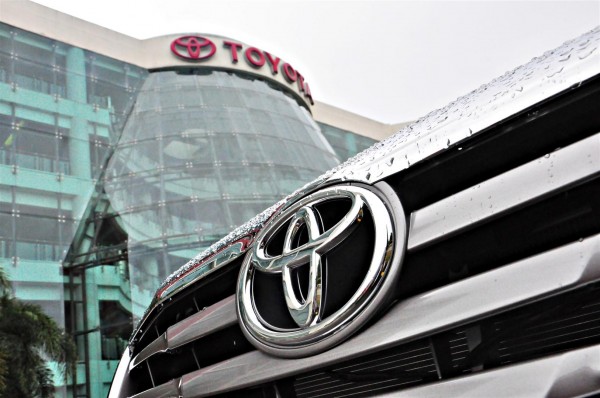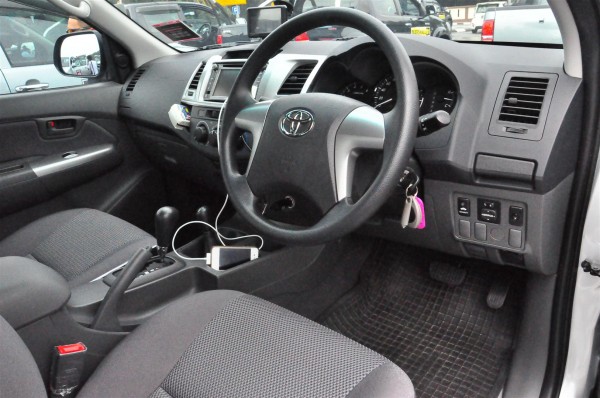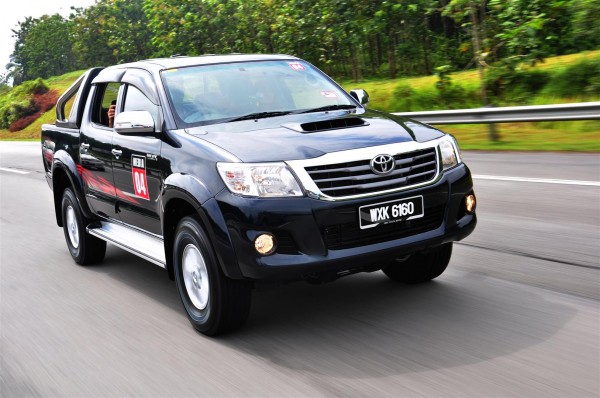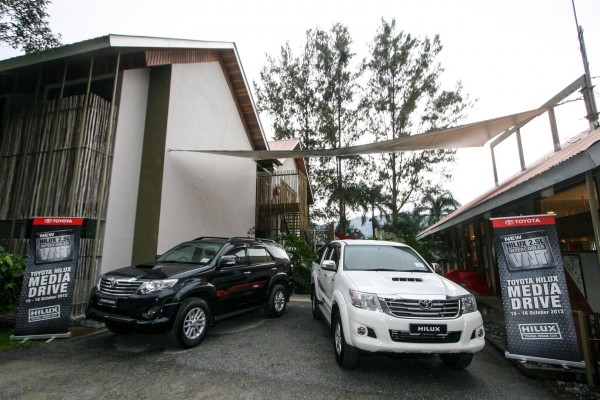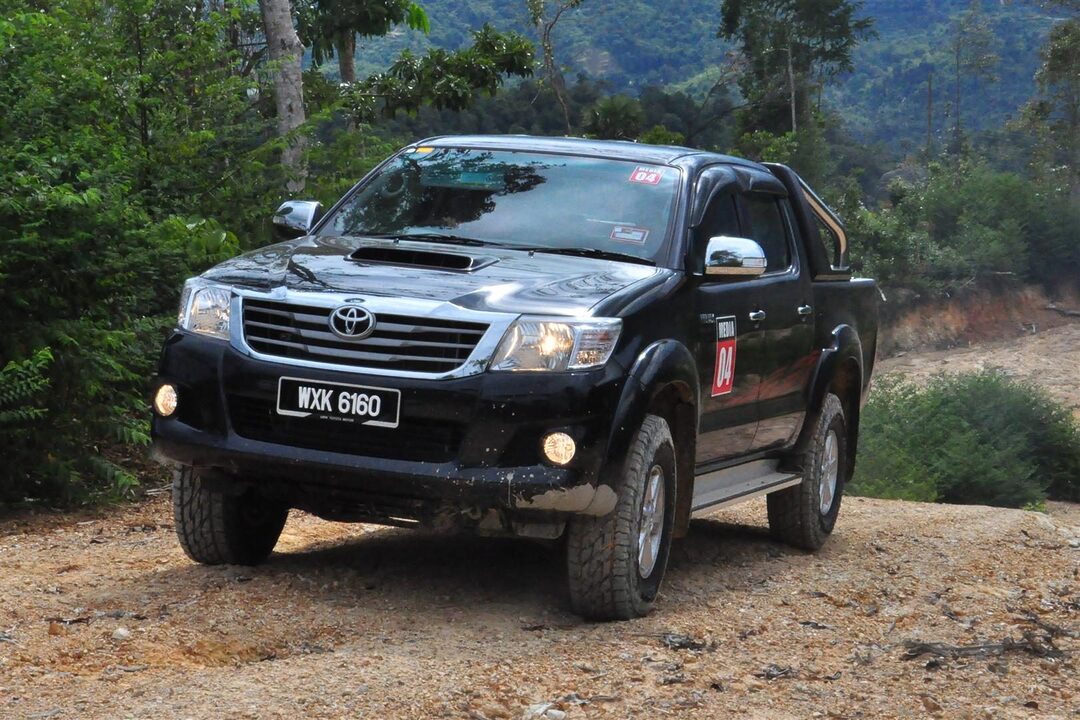We recently joined up with UMW Toyota for a preview of their latest Toyota Hilux that boasts more power and torque thanks to its 2.5L D-4D Common Rail Turbo Diesel engine equipped with an intercooler Variable Nozzle Turbo (VNT). All of which helps put the 2.5L turbo diesel Hilux back into contention with the rest of the competition.
This particular 2.5L Hilux offering from UMW Toyota basically gets the same turbocharger technology found in the Hilux Double Cab 3.0G that was introduced back in 2010. You could say it’s the same engine with a lower displacement.
Currently, UMW Toyota is providing four variants of the new 2.5L Hilux, starting with the Single Cab 2.5 that’s got a price tag of RM76,288 (OTR) as well as a Double Cab 2.5 STD variant at RM86,788 (OTR). Both of these 4×4 variants only come with a manual transmission.
The Hilux Double Cab 2.5G, on the other hand, is made available with both a manual and an automatic transmission that can be had for an On-The-Road price of RM94,988 and RM99,988 respectively.
The 2.5G with an A/T seems to have encroached a little into the 3.0G’s pricing territory, with a difference of roughly RM7,000 separating the two models at RM107,267 (OTR), we begin to wonder if the 3.0G will begin to cannibalize the 2.5G’s sales – or perhaps it could be the other way around. This may cause some confusion in terms of value proposition for the consumer, but if were us, we’d definitely fork out that difference, after all it does seem like you’re getting a better deal having paid a little for a lot more but that’s another topic for discussion.
In any case, we’re here to provide an insight as to how the new 2.5L Hilux with VNT stands up against its predecessor, instead of analysing price points and what not.
With the Intercooler VNT installed into the 2.5L Hilux, it effectively bumps the power output figures to a new level. Where it was at 100bhp at 3,600rpm and 260Nm of torque, the new figures now stand at 142bhp at 3,400rpm and 343Nm of torque. All that twist is now readily accessible between a larger engine speed range of 1,600rpm and 2,800rpm.
Once again the 2.5G encroaches into the 3.0G’s territory in terms of their torque figures, but the difference is that the 3.0G has a higher horsepower rating (161bhp at 3,400rpm) and its torque figure is made readily available on a wider rpm range that lies between 1,400rpm and 3,200rpm. Again, an additional RM7,000 gets you all that – we’re just saying and in terms of warranty, the Hilux gets 3 years or 100,000km (whichever comes first).
How the VNT helps the 2.5L Hilux achieve this is by optimising exhaust gas pressure and flow speed into its turbine by automatically adjusting the opening angle of the vanes on the turbine to be narrow, thus increasing exhaust gas flow speed and pressure to help provide for low-end boost. In doing so, the VNT effectively gives the Hilux greater pulling power at low engine speeds, while increasing fuel efficiency and reducing exhaust emission levels thanks to a cleaner combustion.
And with any turbo unit, it will run hot, which is why it’s been outfitted with an intercooler mounted on top of the engine, allowing it to have that cool bonnet scoop. In addition, there’s even a fuel cooler which helps ensure that the fuel returning to the tank is cooled in order to maintain its viscosity and ensuring the reliability of the fuel system.
The looks of the 2.5L Hilux is anything but pedant, looking very much rough and tough, it almost could be mistaken for the 3.0G lest you’ve a keen eye that knows how to distinguish between the two. But for those who aren’t blessed with such talent, taking a close up look at the rear to find the 2.5 VNT badge will suffice.
On entering the Hilux, it’s pretty much business as usual with high levels of familiarity. Face it, once you’ve found yourself in a Hilux or a Fortuner, they’re all pretty much the same, except it now comes with a double-DIN 6.1” touch screen DVD Audio-Video Navigation System that’s nicely been equipped with a reverse camera and a plethora of cup holders everywhere within the cabin.
The 2.5G Hilux variant gets ABS, Dual SRS Airbags, an immobilizer, LSD and LSP & BV (Load Sensing Proportioning & Bypass Valve). The job of the LSP is to detect if there’s a heavy load in the rear and if so, it’ll automatically communicate with the BV to re-distribute braking pressure evenly in order to ensure for minimum stopping distances. Unfortunately, we weren’t able to test out that part since we didn’t have anything heavy enough to put it into effect. The only thing that was heavy were our heads from waking up at insanely hours just to make it for the drive up to Belum Forest Reserve.
Our drive took us up north via the highway with a stop over in Ipoh for lunch before proceeding onwards to our final destination with a few non-VNT equipped Hilux trailing us from behind.
With boys being boys, there were some instances of shenanigans between AES camera points, but nothing that would even come close to the boundaries of life-threatening and it was at that point that the difference became as apparent as daylight between the old and new.
The 2.5G with VNT literally puts its predecessor to shame in terms of responsiveness and outright high-speed hustle. Where the non-VNT equipped Hilux would struggle to meet the demands of your right foot, the VNT Hilux just seems to smile and provide.
Upon reaching our destination in Ipoh, or I-poh as the Apple generation may like to call it, fuel consumption for the VNT Hilux only saw it sipped as much as a quarter of its tank, whereas its predecessor guzzled about 1/3 of its tank.
After a quick sumptuous lunch, we were now headed for the Belum Rainforest Resort where we were to spend the night and subsequently recharge our batteries, but not before making a surprise stop at a logging camp just before reaching salvation and a hot shower. It was here that we had to switch from 2WD mode to 4WD mode, which can be done while the vehicle is in motion up to a maximum speed of 80kmh by pulling on a smaller gear knob from 2H to 4H.
As with all 4x4s in off-road terrain, it’s always best to be seated up front simply because leaf-springs at the rear are meant to take on load and have no ability to provide any form of comfort what so ever. But in any case, we got to try out the Hilux’s 4×4 capabilities including having the need to shift into 4L for some extremely steep declines that proved rather slippery as rain began to drop, making conditions a little risky. If you didn’t already know, its always best to shift into 4L when the vehicle is stationary even though it’s able to at a maximum speed of 8kmh.
Upon reaching out place of rest, we were happy to find the Toyota Fortuner present as well and were informed that it too comes with the 2.5L VNT engine but its still equipped with a full-time 4×4 drive train, unlike the Hilux.
On-The-Road pricing for the VNT-equipped diesel Fortuner 2.5G (A/T) starts at RM171,288 and the TRD Sportivo variant (also with VNT) comes in at RM174,772.
With the reintroduction of the 2.5L Toyota Hilux and its Intercooler Variable Nozzle Turbo (VNT) technology finding its way into its diesel engine, it’s definitely going to help bring Toyota back into contention with the other manufacturers.


